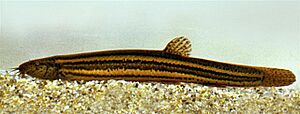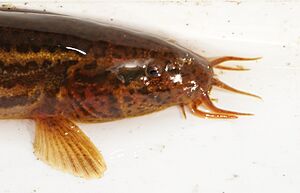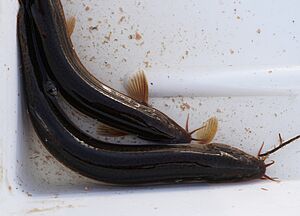Misgurnus fossilis facts for kids
Quick facts for kids Misgurnus fossilis |
|
|---|---|
 |
|
| Conservation status | |
| Scientific classification | |
| Synonyms | |
|
The weatherfish (Misgurnus fossilis) is a cool type of fish called a true loach. It lives in many parts of Europe and some areas of Asia. This fish is a scavenger, meaning it eats whatever it can find at the bottom of rivers and lakes. It uses its special feelers, called barbels, to find food like tiny water bugs and dead plant bits.
The weatherfish is long and thin, which helps it burrow into the mud and swim in tight spots where other fish can't go. It usually grows up to about 30 centimeters (12 inches) long. Some fishermen have even reported catching them up to 45 centimeters (18 inches)! If that's true, it would make the weatherfish the biggest true loach around.
Contents
Where the Weatherfish Lives
This loach can be found in a very wide area, especially across Europe. You can find it north of the Alps mountains. Its home stretches from the Meuse River in western Europe all the way to the Neva River in northwestern Russia.
Weatherfish in Eastern Europe
The weatherfish also lives in the northern part of the Black Sea basin. This includes rivers like the Danube River and the Kuban River. It's also found in the Caspian Sea area, in the River Volga and River Ural drainages. Sometimes, people have introduced this fish to new places. However, it hasn't spread as much as its cousin, the pond loach (Misgurnus anguillicaudatus).
Weatherfish Habitat and Survival
Adult weatherfish like to live in thick patches of water plants. Young weatherfish, called juveniles, prefer to stay near the shoreline. They like very shallow water where there's a lot of detritus, which is decaying plant and animal matter. Neither young nor adult weatherfish are found in open water without plants.
Threats to Weatherfish
Because they love plants so much, activities like dredging (removing mud from the bottom) and clearing aquatic weeds can be dangerous for weatherfish populations. Even though it's listed as a least concern species, meaning it's not currently endangered, the weatherfish is protected in most places where it lives.
How Weatherfish Breathe
One amazing thing about the weatherfish is its ability to survive in places where other fish can't. This is because they can breathe air from above the water! When there's not enough oxygen in the water, the weatherfish will swim to the surface. It then gulps air. This air goes through its intestines, where a special system of blood vessels takes out the oxygen. After that, the fish expels the air from its body. This unique breathing method helps them live in tough conditions.




